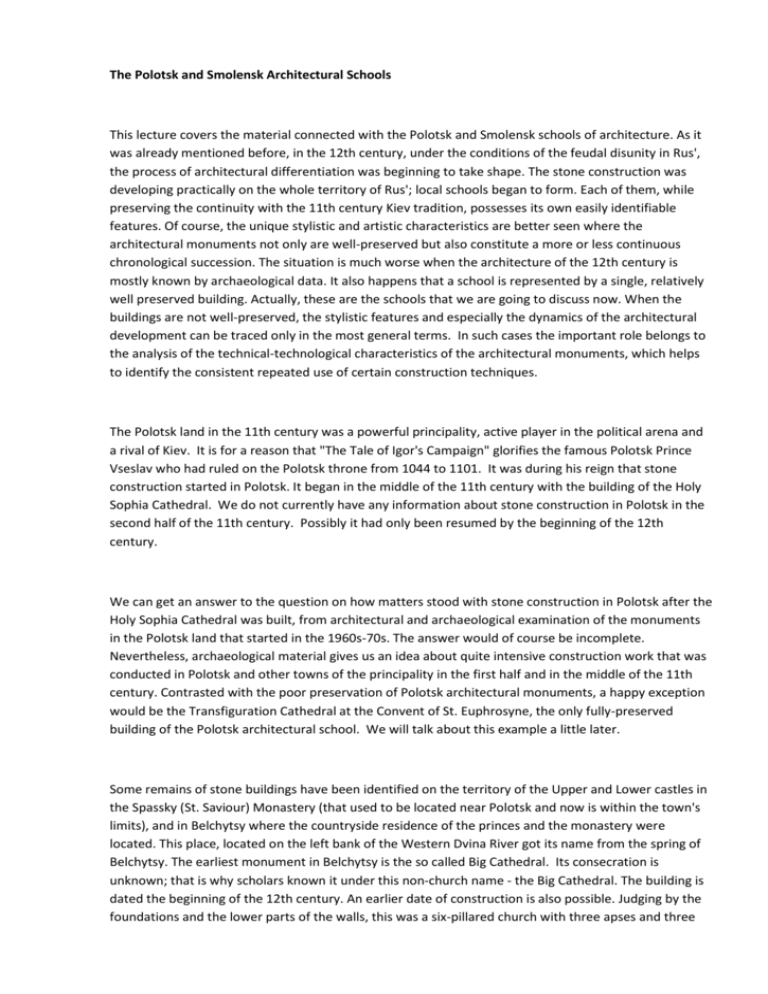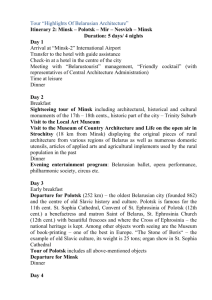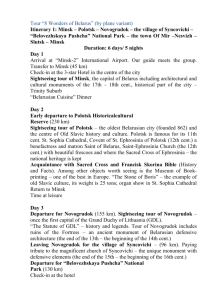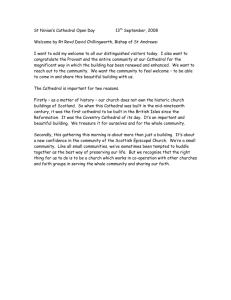The Polotsk and Smolensk Architectural Schools This lecture covers
advertisement

The Polotsk and Smolensk Architectural Schools This lecture covers the material connected with the Polotsk and Smolensk schools of architecture. As it was already mentioned before, in the 12th century, under the conditions of the feudal disunity in Rus', the process of architectural differentiation was beginning to take shape. The stone construction was developing practically on the whole territory of Rus'; local schools began to form. Each of them, while preserving the continuity with the 11th century Kiev tradition, possesses its own easily identifiable features. Of course, the unique stylistic and artistic characteristics are better seen where the architectural monuments not only are well-preserved but also constitute a more or less continuous chronological succession. The situation is much worse when the architecture of the 12th century is mostly known by archaeological data. It also happens that a school is represented by a single, relatively well preserved building. Actually, these are the schools that we are going to discuss now. When the buildings are not well-preserved, the stylistic features and especially the dynamics of the architectural development can be traced only in the most general terms. In such cases the important role belongs to the analysis of the technical-technological characteristics of the architectural monuments, which helps to identify the consistent repeated use of certain construction techniques. The Polotsk land in the 11th century was a powerful principality, active player in the political arena and a rival of Kiev. It is for a reason that "The Tale of Igor's Campaign" glorifies the famous Polotsk Prince Vseslav who had ruled on the Polotsk throne from 1044 to 1101. It was during his reign that stone construction started in Polotsk. It began in the middle of the 11th century with the building of the Holy Sophia Cathedral. We do not currently have any information about stone construction in Polotsk in the second half of the 11th century. Possibly it had only been resumed by the beginning of the 12th century. We can get an answer to the question on how matters stood with stone construction in Polotsk after the Holy Sophia Cathedral was built, from architectural and archaeological examination of the monuments in the Polotsk land that started in the 1960s-70s. The answer would of course be incomplete. Nevertheless, archaeological material gives us an idea about quite intensive construction work that was conducted in Polotsk and other towns of the principality in the first half and in the middle of the 11th century. Contrasted with the poor preservation of Polotsk architectural monuments, a happy exception would be the Transfiguration Cathedral at the Convent of St. Euphrosyne, the only fully-preserved building of the Polotsk architectural school. We will talk about this example a little later. Some remains of stone buildings have been identified on the territory of the Upper and Lower castles in the Spassky (St. Saviour) Monastery (that used to be located near Polotsk and now is within the town's limits), and in Belchytsy where the countryside residence of the princes and the monastery were located. This place, located on the left bank of the Western Dvina River got its name from the spring of Belchytsy. The earliest monument in Belchytsy is the so called Big Cathedral. Its consecration is unknown; that is why scholars known it under this non-church name - the Big Cathedral. The building is dated the beginning of the 12th century. An earlier date of construction is also possible. Judging by the foundations and the lower parts of the walls, this was a six-pillared church with three apses and three vestibules at the northern, western and southern entrances. Its dimensions in plan are 23.5 x 16 m (approximately). The domed square, and this is important, is shifted to the west, i.e. the dome rests on the four western pillars, and not, as it was then usual, on the pairs of eastern ones. For the first time in Polotsk architecture this method was used by the builders of the Holy Sophia Cathedral. Its use in the Belchytsy church is evidence of the continuity in Polotsk architecture. In the presence of the three vestibules, this position of the dome was to emphasize the centered character of the spatial composition, its height. Possibly this church already showed the first signs of the stepped tower-shaped design that would become dominant in the further development of Polotsk architecture and would determine the whole of Old Russian architecture at the end of the 12th century. Another original feature of Polotsk architecture in the per-Mongol period was connected with the masonry technique and the building material. In Polotsk they used only plinfa brick set in the crushedbrick mortar traditional for Old Russian architecture from the end of the 10th century to the beginning of the 13th century. But unlike the masters of the Kiev school, Polotsk builders used the masonry technique with a hidden layer, i.e. plinfa bricks appeared on the face of the wall on each second course. The hidden (in other words, shifted to the inside) layer of plinfa brick was entirely covered with mortar for better binding. The combination of narrow layers of the red brick and plinfa brick, of the red-brown plinfa brick, and the wide layers of pink-coloured mortar created a vivid colorful effect. The masonry technique with the hidden layer of plinfa brick is a typically Polotsk method, a distinctive feature of Polotsk architecture in the 12th century. But construction in Belchytsy did not stop at the building of the Big Cathedral. Here, in the first half of the 12th century, they built two more stone churches, which at the end of the 12th and the beginning of the 13th centuries were joined by yet another stone church. Four stone churches in one monastery is a unique phenomenon for the architecture of the pre-Mongol period. After the Big Cathedral, the Church of St. Boris and St. Gleb and the Church of St. Paraskeva (the Pyatnitskaya tomb church) were built. The Church of St. Boris and St. Gleb, with its elongated plan along the west-east axis, highly prominent central apses and two side apses hidden in the thickness of the wall, forestalls the well-preserved Transfiguration Cathedral at the Convent of St. Euphrosyne. Characteristics of the Pyatnitskaya Church are different. This was a small, church with no pillars and a rectangular apse - not a circular one as it was usual at that time. This design of the sanctuary can be considered original but not unique, for when the Holy Sophia Cathedral was erected in the first half of the 12th century, a baptistery church was built that also had a rectangular apse. Apses of the same shape are known in Smolensk architecture. The ruins of Belchytsy churches, extant up to the vaults, survived the Great Patriotic War but, unfortunately, were demolished in the after-war period. One cannot help mentioning another original church in Belchytsy, known from the drawing of the 18th century. The drawing shows the plan of a typical Polotsk church - very elongated, with one apse in the east and, what is especially important, with semi-circular triconch apses in the north and the south. Similar triconches were found during the excavations in two more Russian towns - Novgorod-Seversky and Putivl. This type of church can be traced back to the monastery tradition of Mount Athos and the Balkans. Each of the churches built in Belchytsy is original when taken separately, but as a whole, unfortunately, they represent a lost architectural ensemble that no doubt used to be the embodiment of Polotsk architecture both stylistically and artistically. Among the early Polotsk churches we find a tomb church of Polotsk bishops in the Spassky Monastery. Its remains were exposed by excavations in the 1960s-70s. The sanctuary did not survive. The main fourpillar building was enclosed on three sides with a gallery that had small no-pillar chapels at its eastern ends. A large number of crypt vaults made of brick were uncovered, and in the northern gallery - an underground burial chamber. According to the written records, this church served as a burial vault for Polotsk bishops. As for princes, they were buried near the Holy Sophia Cathedral, in the burial church built at the beginning of the 12th century. The remains of this building were also uncovered by excavations. The most famous Polotsk church of the 12th century is a well-preserved Cathedral of the Transfiguration of the Saviour at the Convent of St. Euphrosyne. A daughter of Polotsk Prince George Predslav, she, very early in her life, probably as early as the 1120s (and she was born in 1104 or 1106), chose the path of religious devotion. First she spent time in the so called golbets (a special place near the Holy Sophia Cathedral), and then, on the bishop's advice, lived in the village near Polotsk that was called Seltse, where she founded a nunnery and after taking the veil assumed the name of Euphrosyne. The Life of Saint Euphrosyne of Polotsk has survived in later records, and it contains information about a stone church built by the founder of the nunnery. The initiator of the building and probably the architect was, according to the Life, "Ioann, the steward over the church workers", named in the records as Ivan. The Life does not mention when the church was built but we can maintain that the cathedral had been erected before 1161. This was the year when the famous Cross of Saint Euphrosyne of Polotsk was made by Lazar Bohsha and was placed in the Transfiguration Cathedral by Euphrosyne herself. During WWII the cross was lost; its fate is unknown, and this was a remarkable masterpiece of applied art, a sacred relic of the Polotsk land. The church, despite the restoration of its upper part in the 1830s, has survived in a good condition. Studies in the 20th century showed that this was one of the most original buildings of the pre-Mongol period. The church is very important for understanding the dynamics and significance of the development not only of Polotsk architecture but the whole of Old Russian architecture at the end of the 12 and the beginning of the 13th centuries. The plan of the church is very similar to the one of the Church of St. Boris and St. Gleb in Belchytsy. The church is elongated from east to west; the internal composition includes six pillars and a narthex. The sanctuary has one protruding apse and two side apses buried in the thickness of the eastern wall, unidentifiable from the outside. All these are characteristic features of Polotsk architecture of that period. The staircase to the choir loft is located in the western wall; the choir loft is U-shaped. The parts of the choir loft that are protruding to the east, house small cross-shaped chapels covered with dome vaults that cannot be seen from the outside. The narthex and the apse are slightly below the main building structure that has the superstructure of semicircular gables, the zakomari. The church is surmounted by one dome. The most original part of the church is now hidden by later roofing. In the 1920s, the attic of the building was examined. It turned out that under the drum of the church there is a massive cubic-shaped base; each of its four sides is decorated with a trefoil-shaped kokoshnik, a diminutive corbel arch. This structure emphasized the vertical space, gave to the upper part of the building and, taking into account the lowered narthex and apses, to the composition of the church in general, a stepped, circular look. The vertical thrust of the composition is also emphasized by the zakomari that are used here for the first time and the kokoshniki with ogee-shaped crowning elements. The ogee shape of the zakomari and kokoshniki can be seen in Russian architecture not only during the Old Russian period but also in the 18th, the 19th, and even the 20th century. The architect of the church, master Ioann, was undoubtedly an innovator. The Transfiguration Cathedral, and possibly the Church of Boris and Gleb in Belchytsy also built by him earlier, signify the search for a new compositional concept. Here we find the obvious desire of the architect to emphasize the dynamics of the architectural masses, to accentuate the rhythmic intensification towards the center, to strengthen the decorative character of the upper part of the building. This was the first attempt to create a church with a tower-shaped look that we know so well. Innovations of the Polotsk architect would have their development in other schools of Old Russian architecture. And in Polotsk itself, the direct continuation of the innovations introduced by master Ioann in the Transfiguration Cathedral was the church in the Detinets (the fortified center of the town), discovered during the excavations of 1967. The six-pillared church with three vestibules has a sanctuary typical for the Polotsk School. It has a protruding front apse; the side apse is hidden in the eastern wall by the domed square shifted to the west. All these features we can find in earlier buildings a well. The new aspect here is the intricately shaped clustered pilasters that divide the facades of the church's exterior and accentuate its corners. The synthesis of these characteristics in the church built in the Detinets makes it possible to maintain that already in the 1160s-80s and exactly in Polotsk the spatial composition of the tower-shaped stepped church had already developed. Only at the end of the 12th and the beginning of the 13th centuries this type and look of the church would become an all-Russian heritage, determining the character of pre-Mongolian architecture at the final stage of its development. Buildings in other towns of the Polotsk land The remains of a small four-pillared church have been discovered in Minsk. The construction of the church, for some reason, was never completed. The work was stopped after the laying of the foundation. This is why it is so hard to date this church or identify characteristics of its structural and spatial composition, which had apparently been planned but never executed. Possibly the building dates back to the beginning of the 12th century. The only church that was extant up to its vaults, the Church of the Annunciation in Vitebsk (the only surviving building of ancient Vitebsk), was barbarously destroyed in 1961. The remains of the building were conserved following the protests of the public, and in the 1990s, it was rebuilt anew with full restoration of the superstructure and in absence of any documented records. This is a kind of restorative action that does not conform, putting it mildly, to the principles of scientific restoration. In plan, the Vitebsk church is similar to that of the Transfiguration Cathedral in the Convent of St. Euphrosyne. The difference is that its middle nave is planned very competently and consists of almost identical square bays. Another special feature of the Church of the Annunciation is the masonry technique that uses rows of hewn limestone blocks alternating with double layers of plinfa brick. This kind of masonry is otherwise almost unknown in Russian construction practice. Analogues can be found in architectural monuments in Byzantium and the Balkans. The Church of St. Boris and St. Gleb in Novgorod is the only other building where we see this type of masonry technique. The church was uncovered by the excavations under a later building of the same name. This unusual kind of masonry was used in the main building of the Church of St. Boris and St. Gleb. The gallery enclosing the building is built using the typical Polotsk technique, plinfa brick masonry with a hidden layer. After the 1170s-80s, construction in Polotsk gradually died out. This was caused, most probably, by the unfavourable internal situation in the principality, military losses and failures in foreign policy. However, the idea of Polotsk architects, their achievements were not lost. At the end of the 12th and the beginning of the 13th centuries, Polotsk architectural heritage was actively developed outside the Polotsk land. This is first of all true about the architecture of Smolensk. We have already determined that before the 1180s Smolensk architecture had been developing within the tradition of the Dnieper (Kiev-Chernigov) school. The Smolensk school proper started at the beginning of the 1190s with the construction of the Church of the Archangel Michael on the Smyadyn River, in the country residence of Smolensk princes. It was commissioned by David Rostislavich. When the construction was completed, the chronicler, enthusiastically praising the church, says that it had no equal in the northern land. From the 17th to the19th centuries, the church had suffered a lot, had been often redecorated, often rebuilt and had extensions added. Despite the extensive damage, the church retained its spatial and structural concept, and its original look can be reliably reconstructed. This is the only extant and in general well-preserved building of the Smolensk architectural school. It is important that the church was built by a Polotsk architect. This is evidenced by the masonry work that in part uses the Polotsk technique with the hidden layer. But the other walls, a considerable part of them, were built in the Smolensk style, with the regular-course masonry technique typical of the KievChernigov school. The Polotsk origin of the architect is suggested to a much greater extent by the general structure of the plan and the spatial composition. The domed square is shifted to the west, just like in the church in the Detinets. The composition with three vestibules and the design of the sanctuary with two apses that have a circular shape inside and a rectangular shape (rectangular in plan) on the outside, repeat the composition of the Polotsk church. The middle altar jog is shifted to the east and raised with respect to the side ones. The intricately shaped clustered pilasters with slender semicolumns contribute to the vertical thrust of the composition. This undoubtedly brings together the Church of the Archangel Michael in Smolensk and the Polotsk church in the Detinets. In the upper parts of the facades, the vertical lines of clustered pilasters are echoed in the rhythm (very dynamic) of the trefoil-shaped zakomari and the base under the drum, decorated on four sides with kokoshniki, just like the Transfiguration Cathedral in the Convent of St. Euphrosyne. The image of the tower-shaped church with a dynamic, consistently drawn stepped spatial composition is brought to perfection in the Church of the Archangel Michael. The architecture of the Church of the Archangel Michael gave a strong impetus to the development of the original architectural concept in Smolensk architecture. This is proved by the remains of numerous buildings uncovered by the excavations of the 1960s-70s. The full report of these excavations and the description of Smolensk architecture of the pre-Mongol period in general can be found in the monograph written by the scientists who performed the excavation, Nikolai Voronin and Pavel Rapoport, under the title "Architecture of Old Smolensk in the 12th and the 13th Centuries". The direction shaped by the Church of the Archangel Michael was continued in such Smolensk buildings as the cathedral of the Troitsky (Holy Trinity) Monastery on the Klovka River, the Cathedral of the Spassky Monastery near Chernushka village, the church at the mouth of the River Chuvilovka, the church on Voznesenskaya Mountain, etc. These churches are based on the tower-shaped design used in the Church of the Archangel Michael. While the plans, the spatial and structural design of these churches have of course some differences and are marked by certain diversity, their basic concept can be traced back to the Church of the Archangel Michael. A slightly different stylistic intonation we find in a number of other Smolensk churches that are also known to us thanks to the excavations. The dynamic tower-shaped superstructure here gave way, according to the researchers, to a calmer and more traditional design of the upper part. Among these monuments are the cathedral on the Protok, the church at the Okopnoye Cemetery, and the church on the Bolshaya Krasnoflotskaya Street. It is possible that there were two directions in the architecture of Old Smolensk, connected with the work in the town of two construction teams, two building organizations, one of the prince and the other of the bishop. All buildings of the Smolensk school, thus, are confined within a short time frame, from the 1190s to the 1230s. The intensive construction in Smolensk at the end of the 12th and the beginning of the 13th centuries can be compared, perhaps, to the building effort in Novgorod at the same period.






